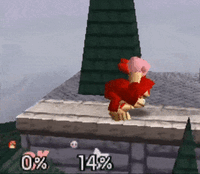
The infinite throw trap, abbreviated as ITT, is a technique in Super Smash Bros. where Donkey Kong grabs the opponent without throwing them, allowing for easy regrabs should they not button mash quickly. It's also possible in Super Smash Bros. Brawl against Lucas and Ness, abusing their unusually long grab release animations.
The technique was removed in Melee through a series of nerfs to Donkey Kong's grab: It has worse startup frame data and range, so he can't grab the opponent quickly enough to start a loop. Even if it were possible, both Donkey Kong and the victim take 10% from a grab release, instead of the victim taking 6% for DK transitioning to the cargo throw stance. In return, Donkey Kong gained new up and down throws, both possessing decent utility, and the addition of pummels gives Donkey Kong some flexibility in how damage is dealt. For the purpose of chain grabs, Donkey Kong can use cargo up throw against fast fallers, or use down throw to force a tech chase.
In Super Smash Bros.
Technical details
After grabbing an opponent, Donkey Kong can use his unique forward throw—the cargo throw—to begin carrying the opponent over his shoulder, an action which deals 8% damage. During the Cargo Throw, Donkey Kong can walk around with the opponent and can choose to perform a proper forward or back throw. The opponent can escape this through button mashing, and multiple inputs can be used at once to escape more quickly.
Once the opponent struggles free, if Donkey Kong is standing still, the frame advantage is roughly neutral, allowing him to grab again, forming the "trap". The opponent has a few frames in which to escape or counter, which decrease as damage is tacked on. The pattern is thusly: Donkey Kong grabs the opponent, initiates the Cargo Throw to deal some damage, the opponent struggles free, Donkey Kong grabs again, and so on.
Effectiveness
Given the variance in tools, hurtboxes, and timing in which they land, each character has different levels of counterplay to the Infinite throw trap. This table summarises their best options.[1]
| Name | Details |
|---|---|
| Kirby | Possible to roll. |
| Ness | Possible to roll. |
| Link | Possible to roll. |
| Captain Falcon | Possible to roll. |
| Pikachu | Quick Attack allows for escape. |
| Samus | Screw Attack allows for escape. |
| Luigi | Super Jump Punch allows for escape, or even a KO if close enough. |
| Mario | Super Jump Punch allows for escape. |
| Fox | Possible to roll. |
| Yoshi | Knockback sends him behind the player if Donkey Kong doesn't move. |
| Jigglypuff | Most consistent. |
| Donkey Kong | Knockback sends him behind the player if Donkey Kong doesn't move. |
| Metal Mario | Super Jump Punch allows for escape. |
| Giant Donkey Kong | ? |
Banning & reinstatement
The Infinite throw trap was historically banned in competitive play, usually due to stalling. As of 2023, however, the technique has been allowed, presumably thanks to counterplay being more adequate and more precise rulings on stalling in general; specifically, deriving intent from the opponent's percentage and gauging the trap's necessity. In general, it is possible to button mash out of the throw trap: The player merely needs to be quick, and if applicable, escape with a proper move. Most high-level Smashers can escape the Infinite throw trap, making it largely a "rookie killer" technique; resultantly, major events tend to ignore the tactic altogether.
Once the Infinite throw trap is started, it is very difficult to escape. Donkey Kong has the largest and widest and non-tether grab range, allowing him to even grab short hopping opponents. This means that even in the event of escape, it is very easy for Donkey Kong to regrab the opponent. Dealing 8% each time, this is a relatively easy way for Donkey Kong to slowly tack on damage before swinging for a KO. Despite appearances, the actual grab release, despite dealing knockback, doesn't actually deal damage. Keyboard players will typically struggle more against the technique due to the button layout.
Over time, counterplay to the strategy has evolved. Some players chose not to button mash, wherein they will stay latched on until Donkey Kong initiates a throw. This leads to a stalemate in which the Donkey Kong, intending to infinite, waits for the opponent to button mash, and the grabbed character, not wanting to deal with escaping the infinite, waits for the Donkey Kong to throw. Should Donkey Kong be at a damage deficit, the throw is forced, lest the player simply time out. In modern times, players will use multiple buttons to mash efficiently and use their best escape options, usually only allowing Donkey Kong to get a few reps in. Therefore, high-level Donkey Kong players will typically focus on a strong combo game involving up aerial and other attacks, rather than relying on the Infinite throw trap.
It is important to note that the technique is escapable through strong button mashing and use of one's proper escape options. Even at high enough percentages, the victim will get knocked down from the release, allowing them to tech.
In Super Smash Bros. Brawl
The Infinite throw trap returns in Brawl, but now can only infinite on Lucas and Ness due to their unusually long grab release animations. All characters will now break free after a certain amount of time, even without button mashing. Because the cargo throw startup doesn't deal damage, Donkey Kong must deal damage through pummels.
Video
Smasher Isai demonstrates the Infinite Throw Trap around the 0:14 mark.